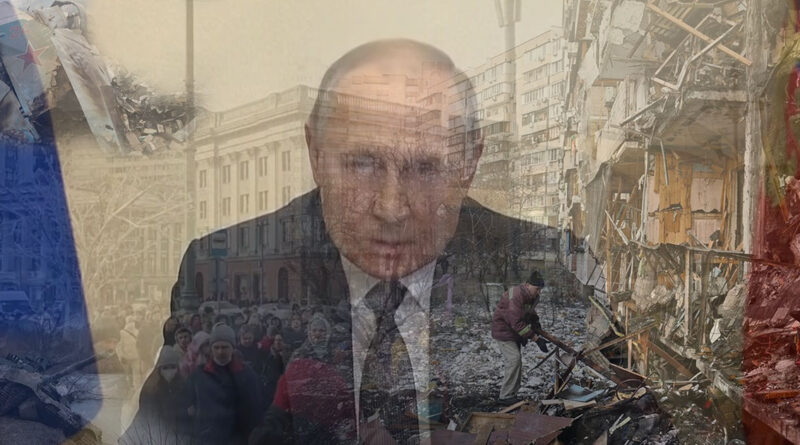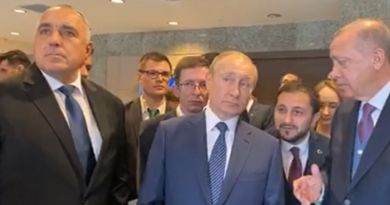Russia loses in every scenario in Ukraine
On February 24th Russian President Vladimir Putin ordered his armed forces to invade another sovereign state, an act of aggression unprecedented since the years of the Second World War. Almost two weeks later, the battle rages on, and its course remains difficult to predict, based on publicly available information. It is clear that this is an aggression with no peer in brazenness and brutality existing in living memory. The invaders have blatantly, and with a bizarre enthusiasm, trodden upon a host of multilateral and bilateral international obligations which Russia had previously undertaken.
One direct consequence has been that in the matter of two-three days the spirit and mood among the political leadership of some of the most influential countries in the world, have shifted fundamentally. Europe has done an about-face in several political trails at once, each of which it had until now followed patiently and persistently for decades.
In the days of uncertainty, most vividly illustrating the cliched expression of “paradigm shift”, we have not only the possibility, but the urgent necessity, to seek the answers to the following several questions. What are the likely courses of development and possible end states of the war? What end state to the conflict has Putin envisioned? What would be the viability and longevity of one or another status quo brought about by armed conflict? What is in store for the region once Putin is no longer in power in Russia?
Even at the current stage of development of the war, there are two massive Russian failures that can safely be named as such. The first one weighs on the intelligence services, in their estimate of the price of the invasion, as measured in damage, human lives and international sanctions measures, as well as in the estimate for the possibility of success in the first place. It is plain to see that the war’s duration will be measured in weeks, not in days. There are a number of telltale signs, which are impossible to conceal, that the offensive is not going to Russian expectations, regardless of Putin’s speech aired on March 3rd. Therefore, the outcome most desirable to the Kremlin – regime change in Kiev with minimal international reaction – is already out of the question.
The scenarios laid out below are founded upon a few base assumptions. The first one is that the current “hot war” in Ukraine has been started against the Kremlin’s preference for the means of achieving its goals. Taking past historical experience into consideration, as well as the opinions of military experts, the most likely original plan was to use special forces to take over government buildings and media headquarters across Kiev, to pronounce a pro-Russian puppet government, and through it, or through pressure exerted upon Zelenskiy, to issue an order to the Ukrainian army to cease resistance. There was a Russian expectation that a considerable proportion of the local population would collaborate with the invaders and with the puppet government. The failure of this plan for taking over Ukraine through burglary and coup, has evoked the fierce and well-organized Ukrainian resistance.
These articles, analyses, and comments are made possible thanks to your empathy and contributions, which are the only guarantors of independence and objectivity in our work. The Alternatives and Analysis team.
The second assumption is that there will be no intervention on the part of NATO, or on the part of another coalition, that would come to Ukraine’s aid.
The third assumption is that Putin will remain in power in Russia at least until the end of the 2020s. With sufficient destabilization of the regime, or during a power struggle commences once Putin has been sent into retirement (in one way or another), the fight for the restoration of Ukraine within its pre-2014 borders will be renewed, which coincidentally will echo the tragic Yugoslavian scenario of 40 years ago.
Scenario 1 – Puppet Regime
Putin brings down Ukraine’s legitimate government through the conquering of important population centers, which are then taken hostage, or through the infliction of enough damage and casualties, so as to make the idea of submission palpable to Ukraine. Russia remains incapable of paying for Ukraine’s occupation, which drags on for months. Russia remains in need of a friendly regime with at least some legitimacy, which would not be brought down and banished from the country, the day the Russian army leaves Kiev. Where would Putin find a candidate willing to take the job? What would the international reaction be? The EU, the US and Britain will obviously not recognize a puppet government in Ukraine. This regime would, in the least, fall under the same sanctions under which Russia finds itself with regard to trade and access to international credit lines. There is no need to even delve into the subject of the Ukrainian people’s abilities – a people with a longstanding tradition in partisan and underground activities in the conditions of hostile occupation – to ignite an invisible resistance against its invaders.
Scenario 2 – Fracturing
Putin fails to achieve regime change in Ukraine, but succeeds in splitting the country, likely across the Dnieper river, reviving the old terms of “right-bank” and “left-bank” Ukraine. All of the problems listed above remain – the filling out of the puppet regime’s government, the sanctions, the maintenance of order in the conquered territories, the lack of international recognition. In addition to these problems, Putin will also face a West Ukraine which would become a member of NATO at the speed of light, and will begin EU accession negotiations, even regardless of its “unresolved territorial issues with neighbors”. In the mid- and long-term, this West Ukraine will serve as an example of a successful state from the former Soviet sphere, and from the former Soviet Union, as well as a beacon of Western values located in the center of the East Slavic geopolitical core. Public sentiment in such an Ukraine would evoke the ever more fiercely anti-Russian Poland, with the added bonus that this will be an East Slavic country, writing with the Cyrillic alphabet, and will be in a strategically advantageous position for attack in any direction. This is potentially an even more dangerous scenario for Putin’s regime than the first one is. It is also evident what will be the direction from which human capital will flow between those two Ukraines.
Scenario 3 – Fortifying of the spoils
Putin limits himself to connecting Crimea with the unrecognized Donetsk and Lugansk “people’s republics”, resurrecting the brand of “New Russia”, which was temporarily brandished for a while in 2014. The newly pronounced state will remain unrecognized by the international community, Russia will remain under sanctions for an indeterminate period. A ruined and ravaged Ukraine, with still imposing strength and potential will enter NATO with wartime speed and will immediately begin arming itself. For evident reasons, such an Ukraine will be a “special” ally in NATO which will resemble Turkey in its waywardness.
Conclusions and paths towards dousing the conflagrations
It is a given that any end state the hostilities might settle at will merely set the stage for prolonged international efforts to prevent a rekindling of the war.
Russia’s constant geopolitical objective has always been to push the borders of its domain as far as possible towards the edges of the Eurasian supercontinent, and farther away from its own geopolitical core. The current war with Ukraine is part of this overarching effort. However, this is happening at the cost of a sharp rise in the risk of a new conflict in the near decades, one in which Russia’s odds for success are very weak.
Unfortunately, it is difficult to imagine a development of the war where the invaders might leave without any kind of concessions on the Ukrainians’ part. Furthermore, if the coming weeks show increasing setbacks for the Russian armed forces’ advance towards its military objectives, or even its being pushed back towards Ukraine’s borders, the most likely next step for Putin would be to increase the threats of nuclear strikes, directed at Ukraine as well as at NATO countries which provide support for Ukraine.
The consequences of the sanctions for Russia’s government are difficult to predict beyond the next 12 months, but it is impossible for Russia’s capability to wage war to have noticeably improved towards mid-2022, much less for the period afterwards. Mobilization is a possible step, but its net utility may turn out to be negative, even only taking into account the obvious logistical impediments for the Russian army, which it is currently experiencing, without the additional mobilization of hundreds of thousands.
With the failure in conventional warfare looking increasingly more apparent, it is becoming highly likely for Putin to try to trade a cease in hostilities for an easing of sanctions. Such a demand may arrive supported by a threat which he could support with a “warning strike” by means of a tactical nuclear weapon hitting a target within Ukraine. With such an, in effect, terrorist strategy Putin would seek on one hand to influence Western public opinion on the question of the easing of sanctions, and on the other – to use fear to break Ukraine’s will to fight and the West’s will to provide it with support.
One expression that has gained popularity recently has been that for the “exit ramp” which supposedly has to be presented to Putin personally, as well as to the Kremlin’s ruling circle, which would presumably trade Putin’s person for an amnesty for their own crimes. The sense in allowing an emergency exit open, is to avoid leaving an adversary who is in possession of nuclear weapons in an all-or-nothing situation, in which he would be tempted to use those weapons.
The problem faced by the world is that, through his bad judgment, Putin has already closed pretty much any visible “exit ramps”. Russian history has shown a centuries-old consistent pattern – rulers who have suffered defeats in war do not remain in power for long. The examples of court-organized coups, before as well as after the Communist revolution, going all the way to the last Russian president, Yeltsin, speak for themselves, and we needn’t discuss them here.
Putin is likely completely clear that he has bet his life on the success of the Ukrainian campaign. This knowledge doubtlessly raises the floor for concessions which he would be willing to make, and because of which he would be ready to take desperate risks. This should prepare us for steps such as temporary public or tacit reductions in the sanctions regime.
Besides negotiations regarding the sanctions, which can always be put on the table, NATO will have opportunities for a more hardball approach in a context in which military action has died down, and the limit of the capabilities of Russian forces has been ascertained. Going by Israel’s example, the public and vigorous military supplying of Ukraine, executed through Ukrainian airports in US transports and in serious quantities, would have a stopping effect in a future phase of the conflict, preventing its reignition.
The situation calls for a diligently thought out diplomatic strategy on the part of NATO and leading democracies, as well as the utilization of all means – both military, diplomatic, and economic – to avert a lasting and irreversible regional or worldwide catastrophe.
These articles, analyses, and comments are made possible thanks to your empathy and contributions, which are the only guarantors of independence and objectivity in our work. The Alternatives and Analysis team.




